Level 5 Business Plan: Lead & Manage Small Business - Love Coffee
VerifiedAdded on 2023/06/12
|33
|8855
|306
Project
AI Summary
This draft business plan outlines the strategy for opening 'Love Coffee House,' a café in Christchurch, New Zealand. It includes an environmental analysis using PESTLE, examining both internal and external factors influencing the business. The plan addresses the impact of the Bi-cultural partnership as outlined in the Treaty of Waitangi, focusing on business activities and relationships. Stakeholder identification and a communication plan are detailed, along with key business functions such as operational, HR, financial, marketing, regulatory, compliance, and risk management plans. The report also incorporates the organization's mission, vision, and ethical considerations, providing a comprehensive framework for the proposed café business. Desklib offers similar solved assignments and past papers for students.
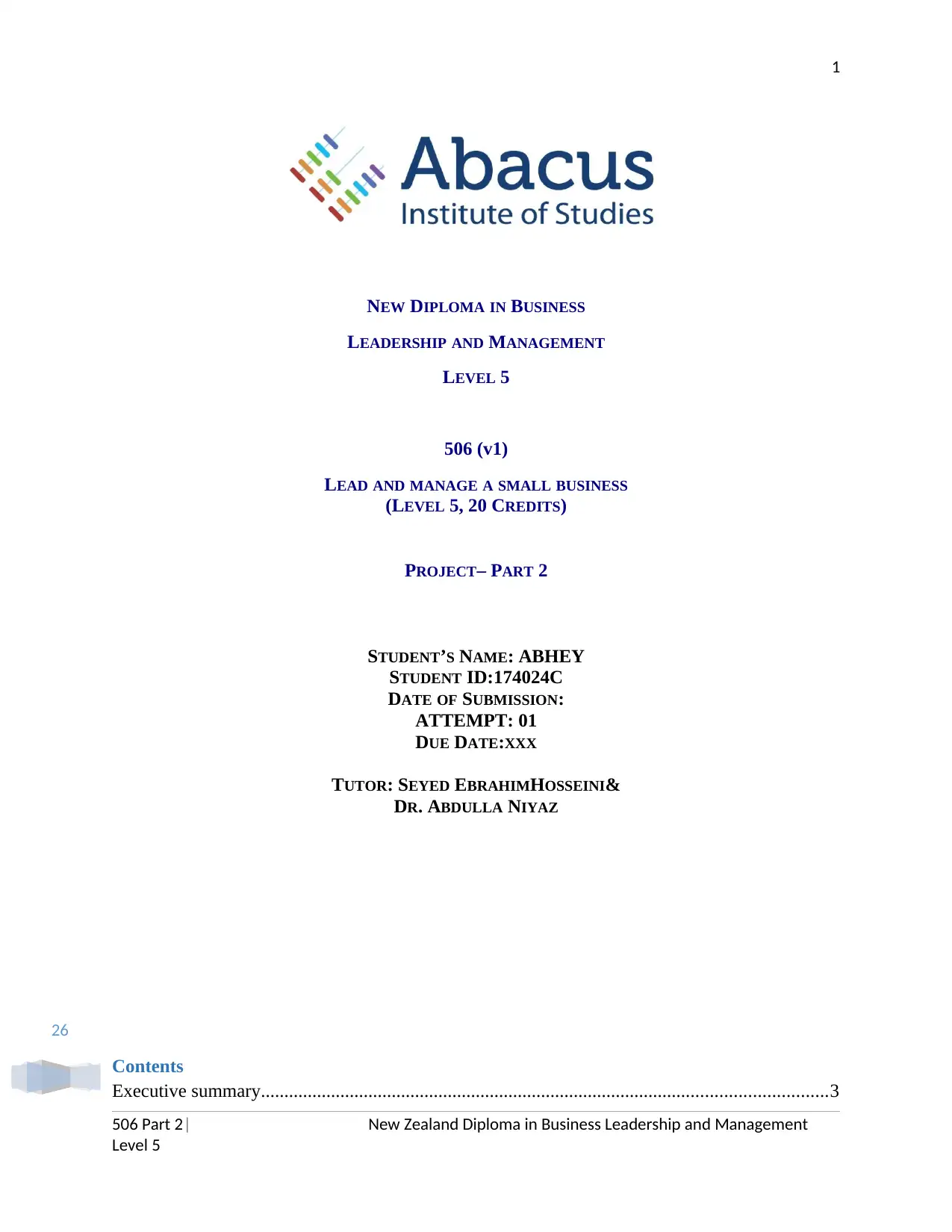
26
1
NEW DIPLOMA IN BUSINESS
LEADERSHIP AND MANAGEMENT
LEVEL 5
506 (v1)
LEAD AND MANAGE A SMALL BUSINESS
(LEVEL 5, 20 CREDITS)
PROJECT– PART 2
STUDENT’S NAME: ABHEY
STUDENT ID:174024C
DATE OF SUBMISSION:
ATTEMPT: 01
DUE DATE:XXX
TUTOR: SEYED EBRAHIMHOSSEINI&
DR. ABDULLA NIYAZ
Contents
Executive summary.........................................................................................................................3
506 Part 2| New Zealand Diploma in Business Leadership and Management
Level 5
1
NEW DIPLOMA IN BUSINESS
LEADERSHIP AND MANAGEMENT
LEVEL 5
506 (v1)
LEAD AND MANAGE A SMALL BUSINESS
(LEVEL 5, 20 CREDITS)
PROJECT– PART 2
STUDENT’S NAME: ABHEY
STUDENT ID:174024C
DATE OF SUBMISSION:
ATTEMPT: 01
DUE DATE:XXX
TUTOR: SEYED EBRAHIMHOSSEINI&
DR. ABDULLA NIYAZ
Contents
Executive summary.........................................................................................................................3
506 Part 2| New Zealand Diploma in Business Leadership and Management
Level 5
Paraphrase This Document
Need a fresh take? Get an instant paraphrase of this document with our AI Paraphraser
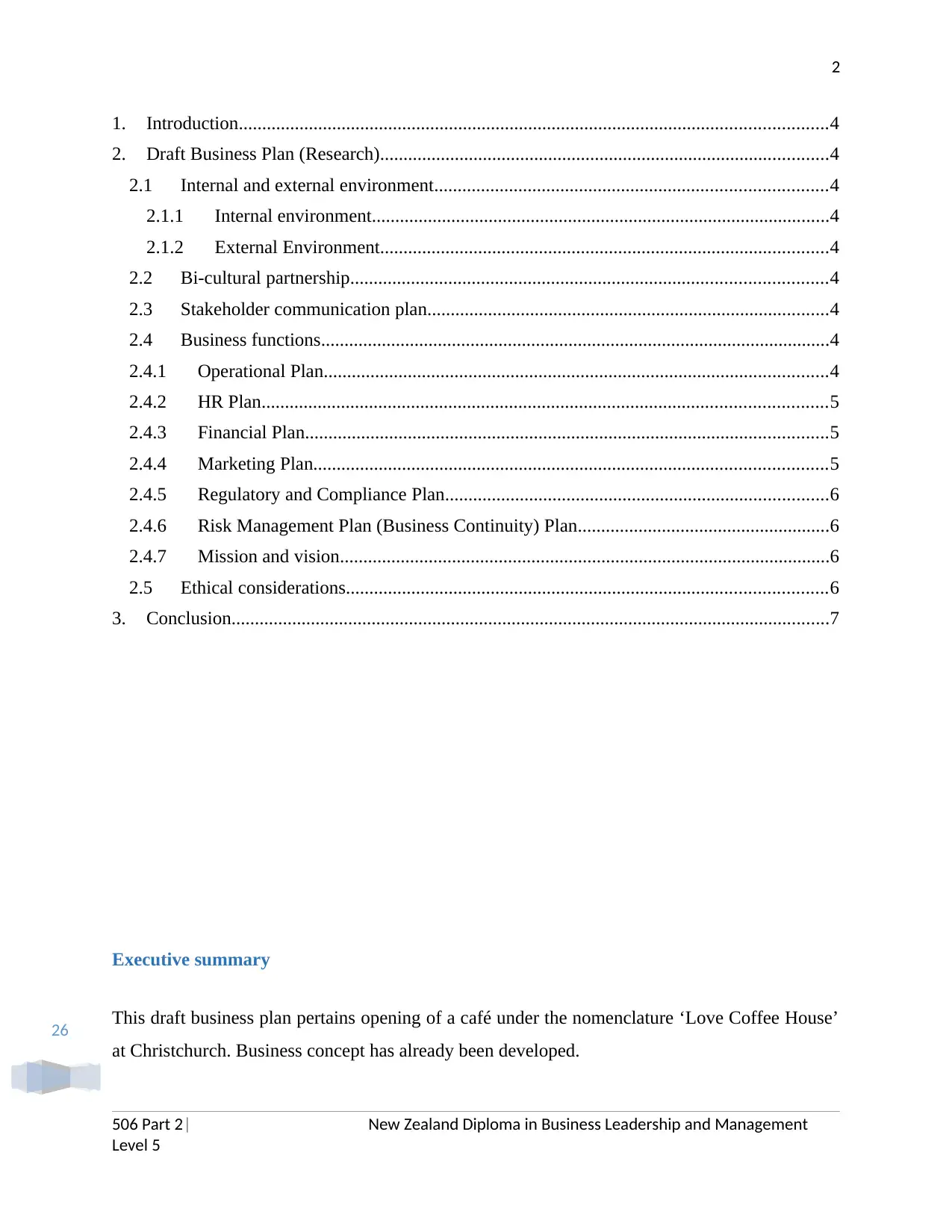
26
2
1. Introduction..............................................................................................................................4
2. Draft Business Plan (Research)................................................................................................4
2.1 Internal and external environment....................................................................................4
2.1.1 Internal environment..................................................................................................4
2.1.2 External Environment................................................................................................4
2.2 Bi-cultural partnership......................................................................................................4
2.3 Stakeholder communication plan......................................................................................4
2.4 Business functions.............................................................................................................4
2.4.1 Operational Plan............................................................................................................4
2.4.2 HR Plan.........................................................................................................................5
2.4.3 Financial Plan................................................................................................................5
2.4.4 Marketing Plan..............................................................................................................5
2.4.5 Regulatory and Compliance Plan..................................................................................6
2.4.6 Risk Management Plan (Business Continuity) Plan......................................................6
2.4.7 Mission and vision.........................................................................................................6
2.5 Ethical considerations.......................................................................................................6
3. Conclusion................................................................................................................................7
Executive summary
This draft business plan pertains opening of a café under the nomenclature ‘Love Coffee House’
at Christchurch. Business concept has already been developed.
506 Part 2| New Zealand Diploma in Business Leadership and Management
Level 5
2
1. Introduction..............................................................................................................................4
2. Draft Business Plan (Research)................................................................................................4
2.1 Internal and external environment....................................................................................4
2.1.1 Internal environment..................................................................................................4
2.1.2 External Environment................................................................................................4
2.2 Bi-cultural partnership......................................................................................................4
2.3 Stakeholder communication plan......................................................................................4
2.4 Business functions.............................................................................................................4
2.4.1 Operational Plan............................................................................................................4
2.4.2 HR Plan.........................................................................................................................5
2.4.3 Financial Plan................................................................................................................5
2.4.4 Marketing Plan..............................................................................................................5
2.4.5 Regulatory and Compliance Plan..................................................................................6
2.4.6 Risk Management Plan (Business Continuity) Plan......................................................6
2.4.7 Mission and vision.........................................................................................................6
2.5 Ethical considerations.......................................................................................................6
3. Conclusion................................................................................................................................7
Executive summary
This draft business plan pertains opening of a café under the nomenclature ‘Love Coffee House’
at Christchurch. Business concept has already been developed.
506 Part 2| New Zealand Diploma in Business Leadership and Management
Level 5
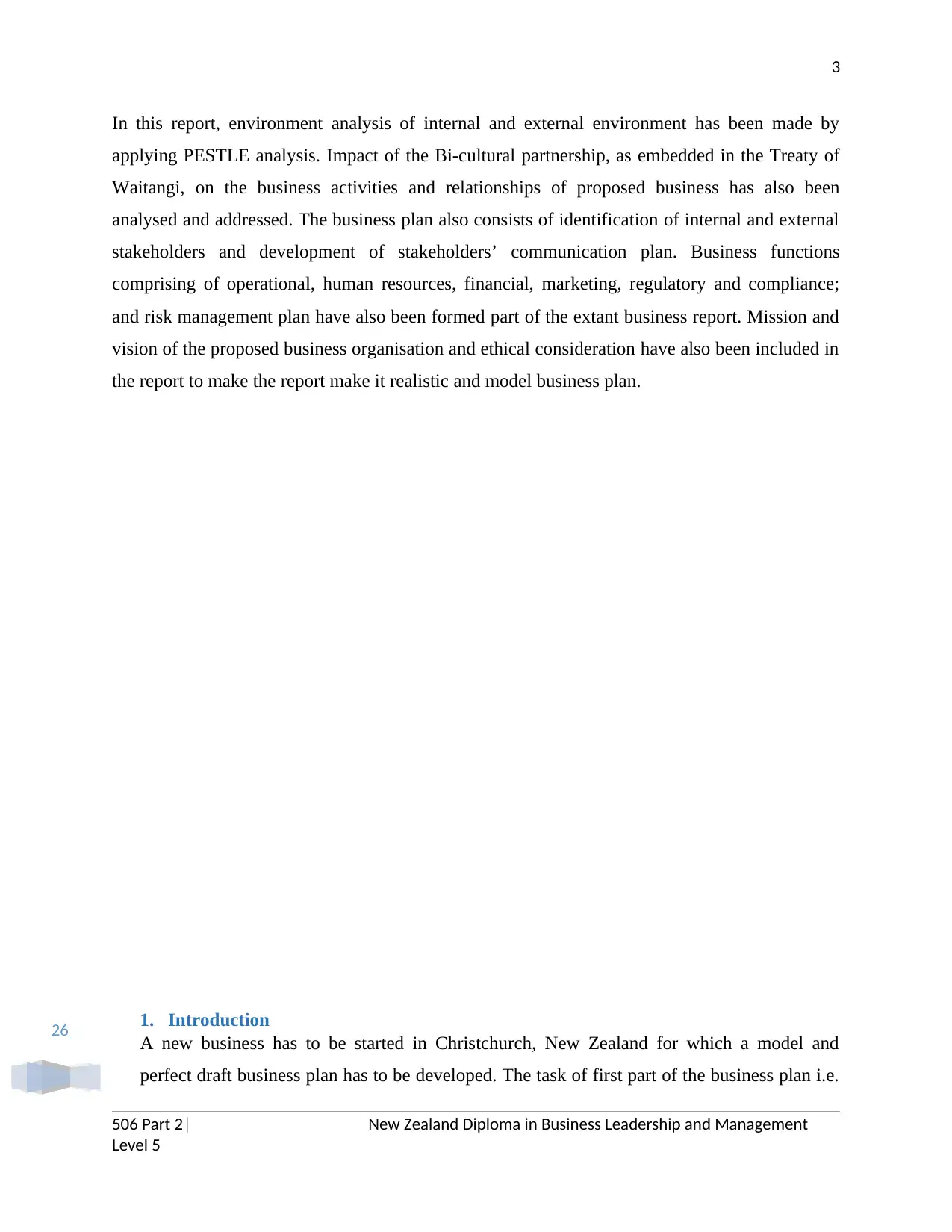
26
3
In this report, environment analysis of internal and external environment has been made by
applying PESTLE analysis. Impact of the Bi-cultural partnership, as embedded in the Treaty of
Waitangi, on the business activities and relationships of proposed business has also been
analysed and addressed. The business plan also consists of identification of internal and external
stakeholders and development of stakeholders’ communication plan. Business functions
comprising of operational, human resources, financial, marketing, regulatory and compliance;
and risk management plan have also been formed part of the extant business report. Mission and
vision of the proposed business organisation and ethical consideration have also been included in
the report to make the report make it realistic and model business plan.
1. Introduction
A new business has to be started in Christchurch, New Zealand for which a model and
perfect draft business plan has to be developed. The task of first part of the business plan i.e.
506 Part 2| New Zealand Diploma in Business Leadership and Management
Level 5
3
In this report, environment analysis of internal and external environment has been made by
applying PESTLE analysis. Impact of the Bi-cultural partnership, as embedded in the Treaty of
Waitangi, on the business activities and relationships of proposed business has also been
analysed and addressed. The business plan also consists of identification of internal and external
stakeholders and development of stakeholders’ communication plan. Business functions
comprising of operational, human resources, financial, marketing, regulatory and compliance;
and risk management plan have also been formed part of the extant business report. Mission and
vision of the proposed business organisation and ethical consideration have also been included in
the report to make the report make it realistic and model business plan.
1. Introduction
A new business has to be started in Christchurch, New Zealand for which a model and
perfect draft business plan has to be developed. The task of first part of the business plan i.e.
506 Part 2| New Zealand Diploma in Business Leadership and Management
Level 5
⊘ This is a preview!⊘
Do you want full access?
Subscribe today to unlock all pages.

Trusted by 1+ million students worldwide
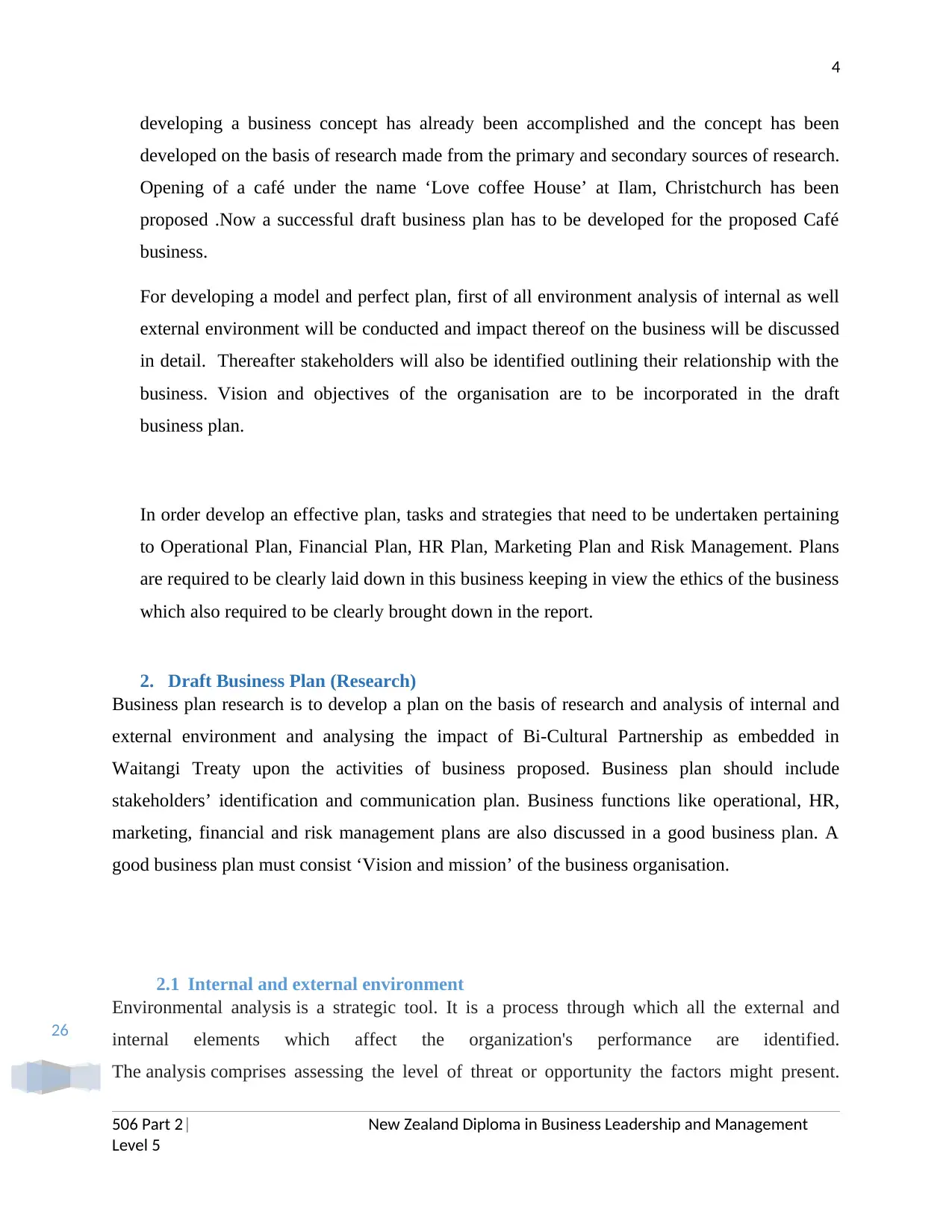
26
4
developing a business concept has already been accomplished and the concept has been
developed on the basis of research made from the primary and secondary sources of research.
Opening of a café under the name ‘Love coffee House’ at Ilam, Christchurch has been
proposed .Now a successful draft business plan has to be developed for the proposed Café
business.
For developing a model and perfect plan, first of all environment analysis of internal as well
external environment will be conducted and impact thereof on the business will be discussed
in detail. Thereafter stakeholders will also be identified outlining their relationship with the
business. Vision and objectives of the organisation are to be incorporated in the draft
business plan.
In order develop an effective plan, tasks and strategies that need to be undertaken pertaining
to Operational Plan, Financial Plan, HR Plan, Marketing Plan and Risk Management. Plans
are required to be clearly laid down in this business keeping in view the ethics of the business
which also required to be clearly brought down in the report.
2. Draft Business Plan (Research)
Business plan research is to develop a plan on the basis of research and analysis of internal and
external environment and analysing the impact of Bi-Cultural Partnership as embedded in
Waitangi Treaty upon the activities of business proposed. Business plan should include
stakeholders’ identification and communication plan. Business functions like operational, HR,
marketing, financial and risk management plans are also discussed in a good business plan. A
good business plan must consist ‘Vision and mission’ of the business organisation.
2.1 Internal and external environment
Environmental analysis is a strategic tool. It is a process through which all the external and
internal elements which affect the organization's performance are identified.
The analysis comprises assessing the level of threat or opportunity the factors might present.
506 Part 2| New Zealand Diploma in Business Leadership and Management
Level 5
4
developing a business concept has already been accomplished and the concept has been
developed on the basis of research made from the primary and secondary sources of research.
Opening of a café under the name ‘Love coffee House’ at Ilam, Christchurch has been
proposed .Now a successful draft business plan has to be developed for the proposed Café
business.
For developing a model and perfect plan, first of all environment analysis of internal as well
external environment will be conducted and impact thereof on the business will be discussed
in detail. Thereafter stakeholders will also be identified outlining their relationship with the
business. Vision and objectives of the organisation are to be incorporated in the draft
business plan.
In order develop an effective plan, tasks and strategies that need to be undertaken pertaining
to Operational Plan, Financial Plan, HR Plan, Marketing Plan and Risk Management. Plans
are required to be clearly laid down in this business keeping in view the ethics of the business
which also required to be clearly brought down in the report.
2. Draft Business Plan (Research)
Business plan research is to develop a plan on the basis of research and analysis of internal and
external environment and analysing the impact of Bi-Cultural Partnership as embedded in
Waitangi Treaty upon the activities of business proposed. Business plan should include
stakeholders’ identification and communication plan. Business functions like operational, HR,
marketing, financial and risk management plans are also discussed in a good business plan. A
good business plan must consist ‘Vision and mission’ of the business organisation.
2.1 Internal and external environment
Environmental analysis is a strategic tool. It is a process through which all the external and
internal elements which affect the organization's performance are identified.
The analysis comprises assessing the level of threat or opportunity the factors might present.
506 Part 2| New Zealand Diploma in Business Leadership and Management
Level 5
Paraphrase This Document
Need a fresh take? Get an instant paraphrase of this document with our AI Paraphraser
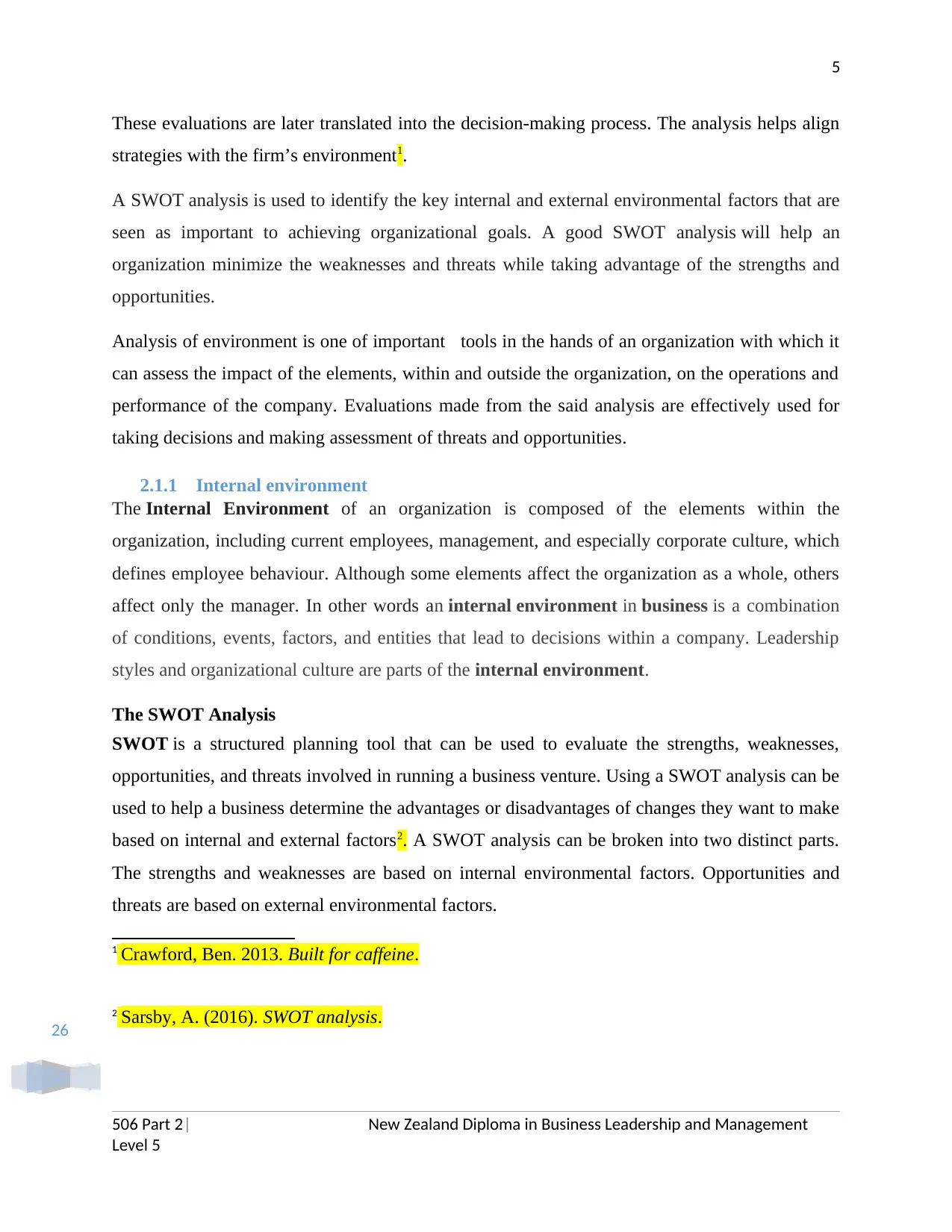
26
5
These evaluations are later translated into the decision-making process. The analysis helps align
strategies with the firm’s environment1.
A SWOT analysis is used to identify the key internal and external environmental factors that are
seen as important to achieving organizational goals. A good SWOT analysis will help an
organization minimize the weaknesses and threats while taking advantage of the strengths and
opportunities.
Analysis of environment is one of important tools in the hands of an organization with which it
can assess the impact of the elements, within and outside the organization, on the operations and
performance of the company. Evaluations made from the said analysis are effectively used for
taking decisions and making assessment of threats and opportunities.
2.1.1 Internal environment
The Internal Environment of an organization is composed of the elements within the
organization, including current employees, management, and especially corporate culture, which
defines employee behaviour. Although some elements affect the organization as a whole, others
affect only the manager. In other words an internal environment in business is a combination
of conditions, events, factors, and entities that lead to decisions within a company. Leadership
styles and organizational culture are parts of the internal environment.
The SWOT Analysis
SWOT is a structured planning tool that can be used to evaluate the strengths, weaknesses,
opportunities, and threats involved in running a business venture. Using a SWOT analysis can be
used to help a business determine the advantages or disadvantages of changes they want to make
based on internal and external factors2. A SWOT analysis can be broken into two distinct parts.
The strengths and weaknesses are based on internal environmental factors. Opportunities and
threats are based on external environmental factors.
1 Crawford, Ben. 2013. Built for caffeine.
2 Sarsby, A. (2016). SWOT analysis.
506 Part 2| New Zealand Diploma in Business Leadership and Management
Level 5
5
These evaluations are later translated into the decision-making process. The analysis helps align
strategies with the firm’s environment1.
A SWOT analysis is used to identify the key internal and external environmental factors that are
seen as important to achieving organizational goals. A good SWOT analysis will help an
organization minimize the weaknesses and threats while taking advantage of the strengths and
opportunities.
Analysis of environment is one of important tools in the hands of an organization with which it
can assess the impact of the elements, within and outside the organization, on the operations and
performance of the company. Evaluations made from the said analysis are effectively used for
taking decisions and making assessment of threats and opportunities.
2.1.1 Internal environment
The Internal Environment of an organization is composed of the elements within the
organization, including current employees, management, and especially corporate culture, which
defines employee behaviour. Although some elements affect the organization as a whole, others
affect only the manager. In other words an internal environment in business is a combination
of conditions, events, factors, and entities that lead to decisions within a company. Leadership
styles and organizational culture are parts of the internal environment.
The SWOT Analysis
SWOT is a structured planning tool that can be used to evaluate the strengths, weaknesses,
opportunities, and threats involved in running a business venture. Using a SWOT analysis can be
used to help a business determine the advantages or disadvantages of changes they want to make
based on internal and external factors2. A SWOT analysis can be broken into two distinct parts.
The strengths and weaknesses are based on internal environmental factors. Opportunities and
threats are based on external environmental factors.
1 Crawford, Ben. 2013. Built for caffeine.
2 Sarsby, A. (2016). SWOT analysis.
506 Part 2| New Zealand Diploma in Business Leadership and Management
Level 5
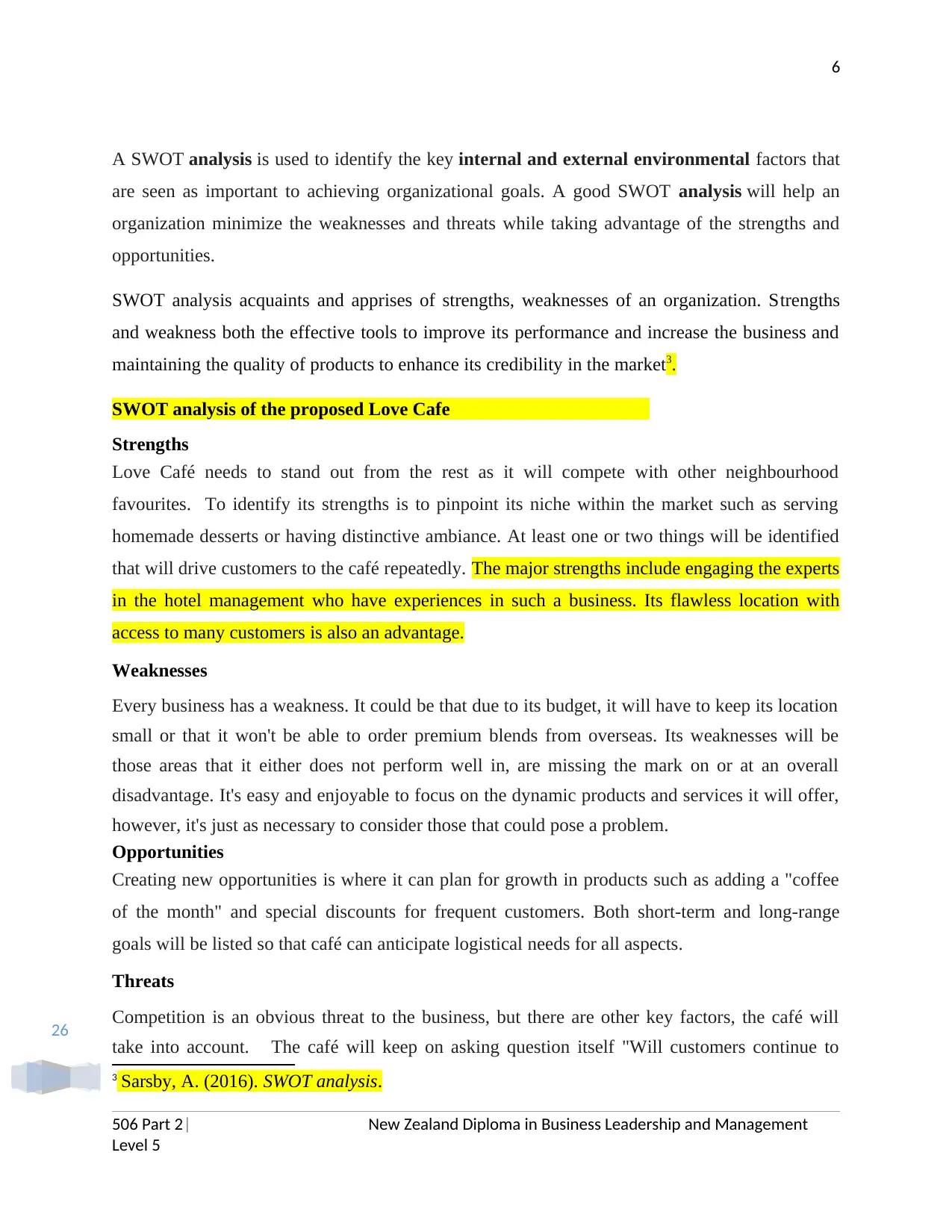
26
6
A SWOT analysis is used to identify the key internal and external environmental factors that
are seen as important to achieving organizational goals. A good SWOT analysis will help an
organization minimize the weaknesses and threats while taking advantage of the strengths and
opportunities.
SWOT analysis acquaints and apprises of strengths, weaknesses of an organization. Strengths
and weakness both the effective tools to improve its performance and increase the business and
maintaining the quality of products to enhance its credibility in the market3.
SWOT analysis of the proposed Love Cafe
Strengths
Love Café needs to stand out from the rest as it will compete with other neighbourhood
favourites. To identify its strengths is to pinpoint its niche within the market such as serving
homemade desserts or having distinctive ambiance. At least one or two things will be identified
that will drive customers to the café repeatedly. The major strengths include engaging the experts
in the hotel management who have experiences in such a business. Its flawless location with
access to many customers is also an advantage.
Weaknesses
Every business has a weakness. It could be that due to its budget, it will have to keep its location
small or that it won't be able to order premium blends from overseas. Its weaknesses will be
those areas that it either does not perform well in, are missing the mark on or at an overall
disadvantage. It's easy and enjoyable to focus on the dynamic products and services it will offer,
however, it's just as necessary to consider those that could pose a problem.
Opportunities
Creating new opportunities is where it can plan for growth in products such as adding a "coffee
of the month" and special discounts for frequent customers. Both short-term and long-range
goals will be listed so that café can anticipate logistical needs for all aspects.
Threats
Competition is an obvious threat to the business, but there are other key factors, the café will
take into account. The café will keep on asking question itself "Will customers continue to
3 Sarsby, A. (2016). SWOT analysis.
506 Part 2| New Zealand Diploma in Business Leadership and Management
Level 5
6
A SWOT analysis is used to identify the key internal and external environmental factors that
are seen as important to achieving organizational goals. A good SWOT analysis will help an
organization minimize the weaknesses and threats while taking advantage of the strengths and
opportunities.
SWOT analysis acquaints and apprises of strengths, weaknesses of an organization. Strengths
and weakness both the effective tools to improve its performance and increase the business and
maintaining the quality of products to enhance its credibility in the market3.
SWOT analysis of the proposed Love Cafe
Strengths
Love Café needs to stand out from the rest as it will compete with other neighbourhood
favourites. To identify its strengths is to pinpoint its niche within the market such as serving
homemade desserts or having distinctive ambiance. At least one or two things will be identified
that will drive customers to the café repeatedly. The major strengths include engaging the experts
in the hotel management who have experiences in such a business. Its flawless location with
access to many customers is also an advantage.
Weaknesses
Every business has a weakness. It could be that due to its budget, it will have to keep its location
small or that it won't be able to order premium blends from overseas. Its weaknesses will be
those areas that it either does not perform well in, are missing the mark on or at an overall
disadvantage. It's easy and enjoyable to focus on the dynamic products and services it will offer,
however, it's just as necessary to consider those that could pose a problem.
Opportunities
Creating new opportunities is where it can plan for growth in products such as adding a "coffee
of the month" and special discounts for frequent customers. Both short-term and long-range
goals will be listed so that café can anticipate logistical needs for all aspects.
Threats
Competition is an obvious threat to the business, but there are other key factors, the café will
take into account. The café will keep on asking question itself "Will customers continue to
3 Sarsby, A. (2016). SWOT analysis.
506 Part 2| New Zealand Diploma in Business Leadership and Management
Level 5
⊘ This is a preview!⊘
Do you want full access?
Subscribe today to unlock all pages.

Trusted by 1+ million students worldwide
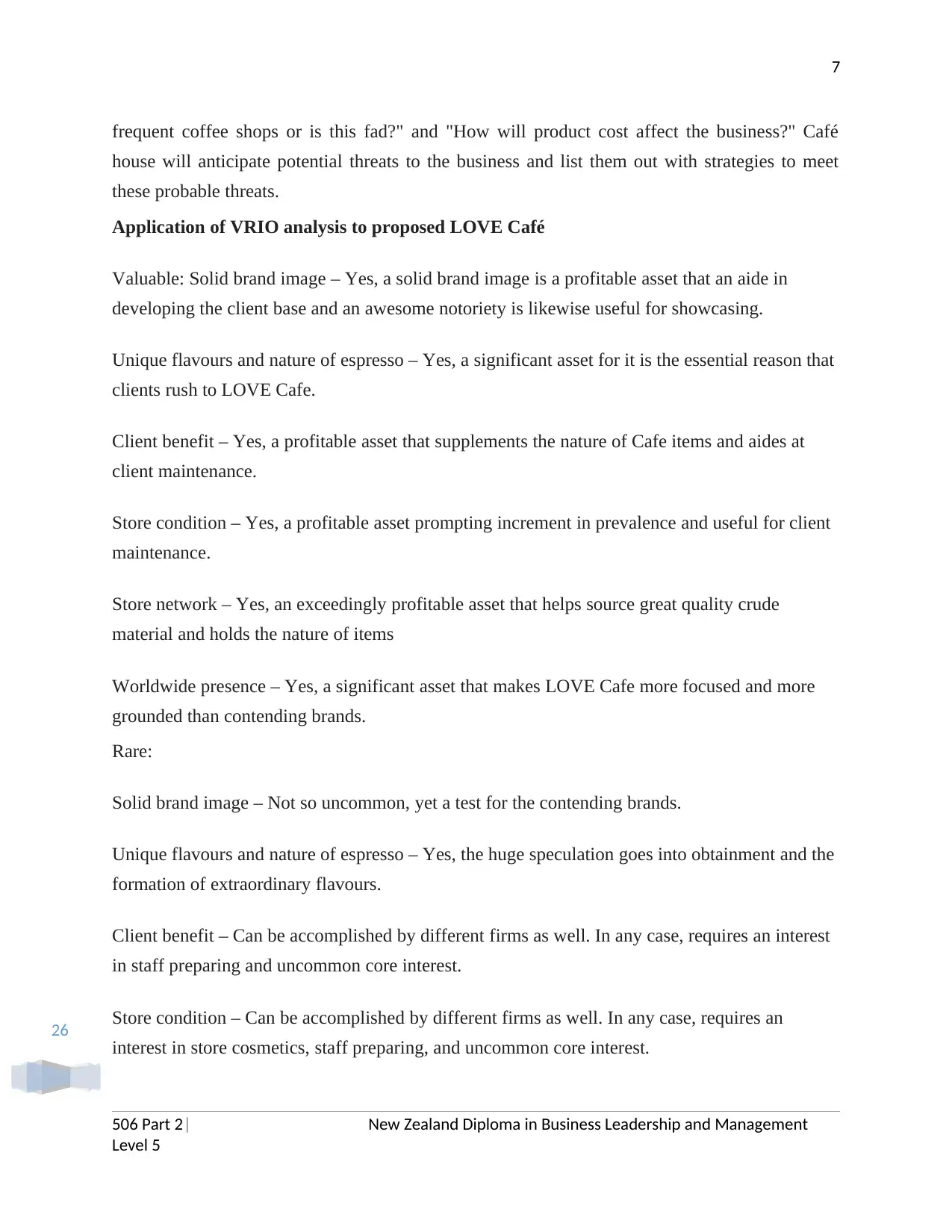
26
7
frequent coffee shops or is this fad?" and "How will product cost affect the business?" Café
house will anticipate potential threats to the business and list them out with strategies to meet
these probable threats.
Application of VRIO analysis to proposed LOVE Café
Valuable: Solid brand image – Yes, a solid brand image is a profitable asset that an aide in
developing the client base and an awesome notoriety is likewise useful for showcasing.
Unique flavours and nature of espresso – Yes, a significant asset for it is the essential reason that
clients rush to LOVE Cafe.
Client benefit – Yes, a profitable asset that supplements the nature of Cafe items and aides at
client maintenance.
Store condition – Yes, a profitable asset prompting increment in prevalence and useful for client
maintenance.
Store network – Yes, an exceedingly profitable asset that helps source great quality crude
material and holds the nature of items
Worldwide presence – Yes, a significant asset that makes LOVE Cafe more focused and more
grounded than contending brands.
Rare:
Solid brand image – Not so uncommon, yet a test for the contending brands.
Unique flavours and nature of espresso – Yes, the huge speculation goes into obtainment and the
formation of extraordinary flavours.
Client benefit – Can be accomplished by different firms as well. In any case, requires an interest
in staff preparing and uncommon core interest.
Store condition – Can be accomplished by different firms as well. In any case, requires an
interest in store cosmetics, staff preparing, and uncommon core interest.
506 Part 2| New Zealand Diploma in Business Leadership and Management
Level 5
7
frequent coffee shops or is this fad?" and "How will product cost affect the business?" Café
house will anticipate potential threats to the business and list them out with strategies to meet
these probable threats.
Application of VRIO analysis to proposed LOVE Café
Valuable: Solid brand image – Yes, a solid brand image is a profitable asset that an aide in
developing the client base and an awesome notoriety is likewise useful for showcasing.
Unique flavours and nature of espresso – Yes, a significant asset for it is the essential reason that
clients rush to LOVE Cafe.
Client benefit – Yes, a profitable asset that supplements the nature of Cafe items and aides at
client maintenance.
Store condition – Yes, a profitable asset prompting increment in prevalence and useful for client
maintenance.
Store network – Yes, an exceedingly profitable asset that helps source great quality crude
material and holds the nature of items
Worldwide presence – Yes, a significant asset that makes LOVE Cafe more focused and more
grounded than contending brands.
Rare:
Solid brand image – Not so uncommon, yet a test for the contending brands.
Unique flavours and nature of espresso – Yes, the huge speculation goes into obtainment and the
formation of extraordinary flavours.
Client benefit – Can be accomplished by different firms as well. In any case, requires an interest
in staff preparing and uncommon core interest.
Store condition – Can be accomplished by different firms as well. In any case, requires an
interest in store cosmetics, staff preparing, and uncommon core interest.
506 Part 2| New Zealand Diploma in Business Leadership and Management
Level 5
Paraphrase This Document
Need a fresh take? Get an instant paraphrase of this document with our AI Paraphraser
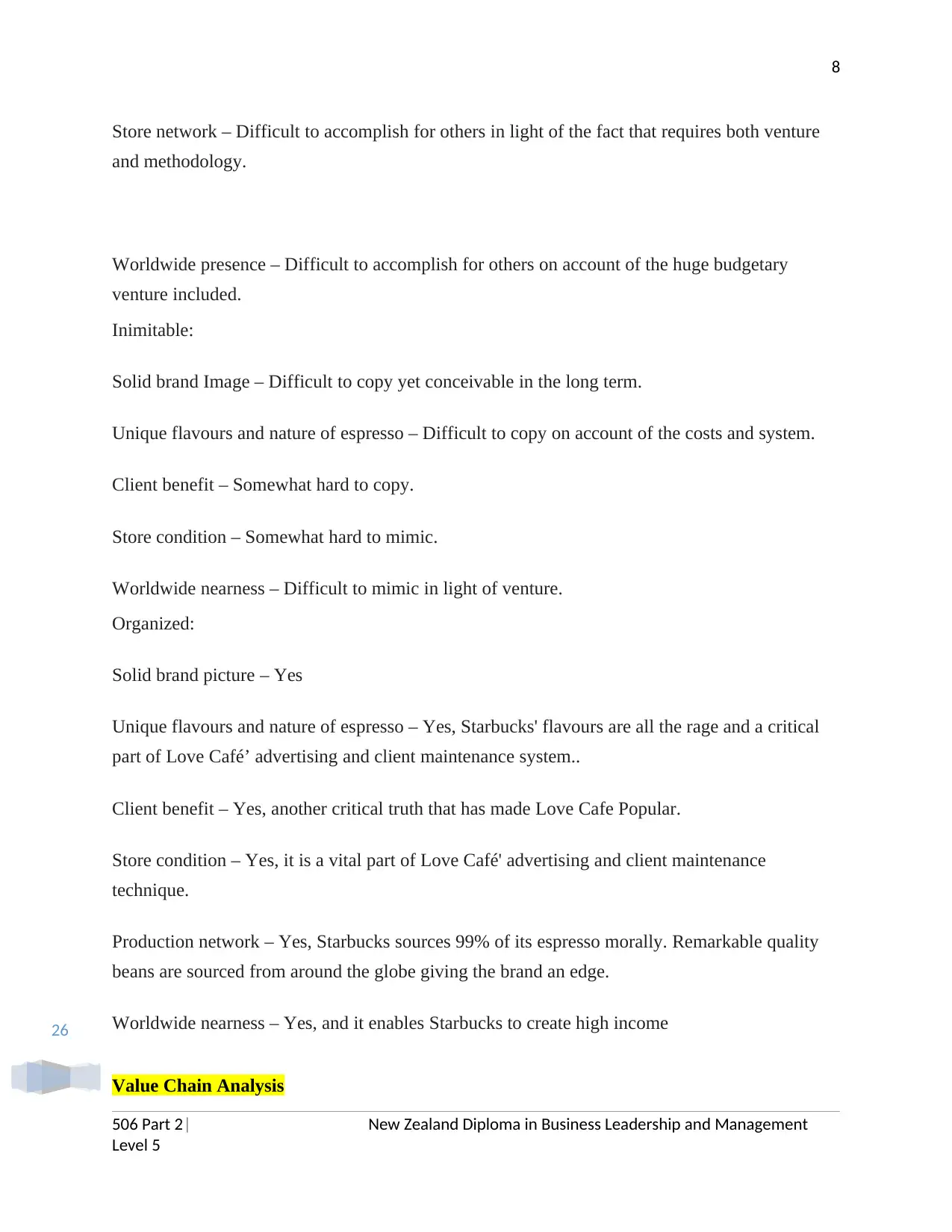
26
8
Store network – Difficult to accomplish for others in light of the fact that requires both venture
and methodology.
Worldwide presence – Difficult to accomplish for others on account of the huge budgetary
venture included.
Inimitable:
Solid brand Image – Difficult to copy yet conceivable in the long term.
Unique flavours and nature of espresso – Difficult to copy on account of the costs and system.
Client benefit – Somewhat hard to copy.
Store condition – Somewhat hard to mimic.
Worldwide nearness – Difficult to mimic in light of venture.
Organized:
Solid brand picture – Yes
Unique flavours and nature of espresso – Yes, Starbucks' flavours are all the rage and a critical
part of Love Café’ advertising and client maintenance system..
Client benefit – Yes, another critical truth that has made Love Cafe Popular.
Store condition – Yes, it is a vital part of Love Café' advertising and client maintenance
technique.
Production network – Yes, Starbucks sources 99% of its espresso morally. Remarkable quality
beans are sourced from around the globe giving the brand an edge.
Worldwide nearness – Yes, and it enables Starbucks to create high income
Value Chain Analysis
506 Part 2| New Zealand Diploma in Business Leadership and Management
Level 5
8
Store network – Difficult to accomplish for others in light of the fact that requires both venture
and methodology.
Worldwide presence – Difficult to accomplish for others on account of the huge budgetary
venture included.
Inimitable:
Solid brand Image – Difficult to copy yet conceivable in the long term.
Unique flavours and nature of espresso – Difficult to copy on account of the costs and system.
Client benefit – Somewhat hard to copy.
Store condition – Somewhat hard to mimic.
Worldwide nearness – Difficult to mimic in light of venture.
Organized:
Solid brand picture – Yes
Unique flavours and nature of espresso – Yes, Starbucks' flavours are all the rage and a critical
part of Love Café’ advertising and client maintenance system..
Client benefit – Yes, another critical truth that has made Love Cafe Popular.
Store condition – Yes, it is a vital part of Love Café' advertising and client maintenance
technique.
Production network – Yes, Starbucks sources 99% of its espresso morally. Remarkable quality
beans are sourced from around the globe giving the brand an edge.
Worldwide nearness – Yes, and it enables Starbucks to create high income
Value Chain Analysis
506 Part 2| New Zealand Diploma in Business Leadership and Management
Level 5
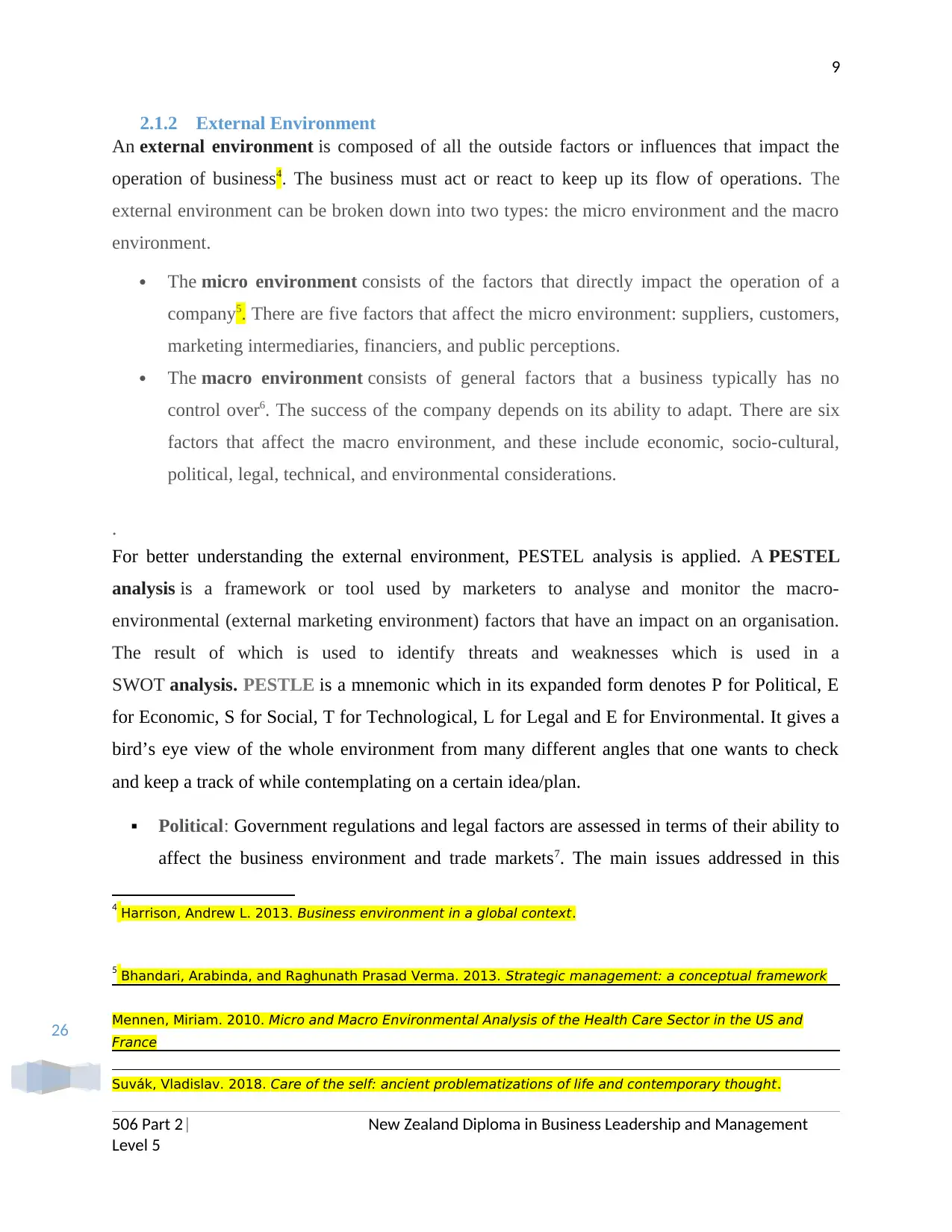
26
9
2.1.2 External Environment
An external environment is composed of all the outside factors or influences that impact the
operation of business4. The business must act or react to keep up its flow of operations. The
external environment can be broken down into two types: the micro environment and the macro
environment.
The micro environment consists of the factors that directly impact the operation of a
company5. There are five factors that affect the micro environment: suppliers, customers,
marketing intermediaries, financiers, and public perceptions.
The macro environment consists of general factors that a business typically has no
control over6. The success of the company depends on its ability to adapt. There are six
factors that affect the macro environment, and these include economic, socio-cultural,
political, legal, technical, and environmental considerations.
.
For better understanding the external environment, PESTEL analysis is applied. A PESTEL
analysis is a framework or tool used by marketers to analyse and monitor the macro-
environmental (external marketing environment) factors that have an impact on an organisation.
The result of which is used to identify threats and weaknesses which is used in a
SWOT analysis. PESTLE is a mnemonic which in its expanded form denotes P for Political, E
for Economic, S for Social, T for Technological, L for Legal and E for Environmental. It gives a
bird’s eye view of the whole environment from many different angles that one wants to check
and keep a track of while contemplating on a certain idea/plan.
Political: Government regulations and legal factors are assessed in terms of their ability to
affect the business environment and trade markets7. The main issues addressed in this
4 Harrison, Andrew L. 2013. Business environment in a global context.
5 Bhandari, Arabinda, and Raghunath Prasad Verma. 2013. Strategic management: a conceptual framework
Mennen, Miriam. 2010. Micro and Macro Environmental Analysis of the Health Care Sector in the US and
France
Suvák, Vladislav. 2018. Care of the self: ancient problematizations of life and contemporary thought.
506 Part 2| New Zealand Diploma in Business Leadership and Management
Level 5
9
2.1.2 External Environment
An external environment is composed of all the outside factors or influences that impact the
operation of business4. The business must act or react to keep up its flow of operations. The
external environment can be broken down into two types: the micro environment and the macro
environment.
The micro environment consists of the factors that directly impact the operation of a
company5. There are five factors that affect the micro environment: suppliers, customers,
marketing intermediaries, financiers, and public perceptions.
The macro environment consists of general factors that a business typically has no
control over6. The success of the company depends on its ability to adapt. There are six
factors that affect the macro environment, and these include economic, socio-cultural,
political, legal, technical, and environmental considerations.
.
For better understanding the external environment, PESTEL analysis is applied. A PESTEL
analysis is a framework or tool used by marketers to analyse and monitor the macro-
environmental (external marketing environment) factors that have an impact on an organisation.
The result of which is used to identify threats and weaknesses which is used in a
SWOT analysis. PESTLE is a mnemonic which in its expanded form denotes P for Political, E
for Economic, S for Social, T for Technological, L for Legal and E for Environmental. It gives a
bird’s eye view of the whole environment from many different angles that one wants to check
and keep a track of while contemplating on a certain idea/plan.
Political: Government regulations and legal factors are assessed in terms of their ability to
affect the business environment and trade markets7. The main issues addressed in this
4 Harrison, Andrew L. 2013. Business environment in a global context.
5 Bhandari, Arabinda, and Raghunath Prasad Verma. 2013. Strategic management: a conceptual framework
Mennen, Miriam. 2010. Micro and Macro Environmental Analysis of the Health Care Sector in the US and
France
Suvák, Vladislav. 2018. Care of the self: ancient problematizations of life and contemporary thought.
506 Part 2| New Zealand Diploma in Business Leadership and Management
Level 5
⊘ This is a preview!⊘
Do you want full access?
Subscribe today to unlock all pages.

Trusted by 1+ million students worldwide
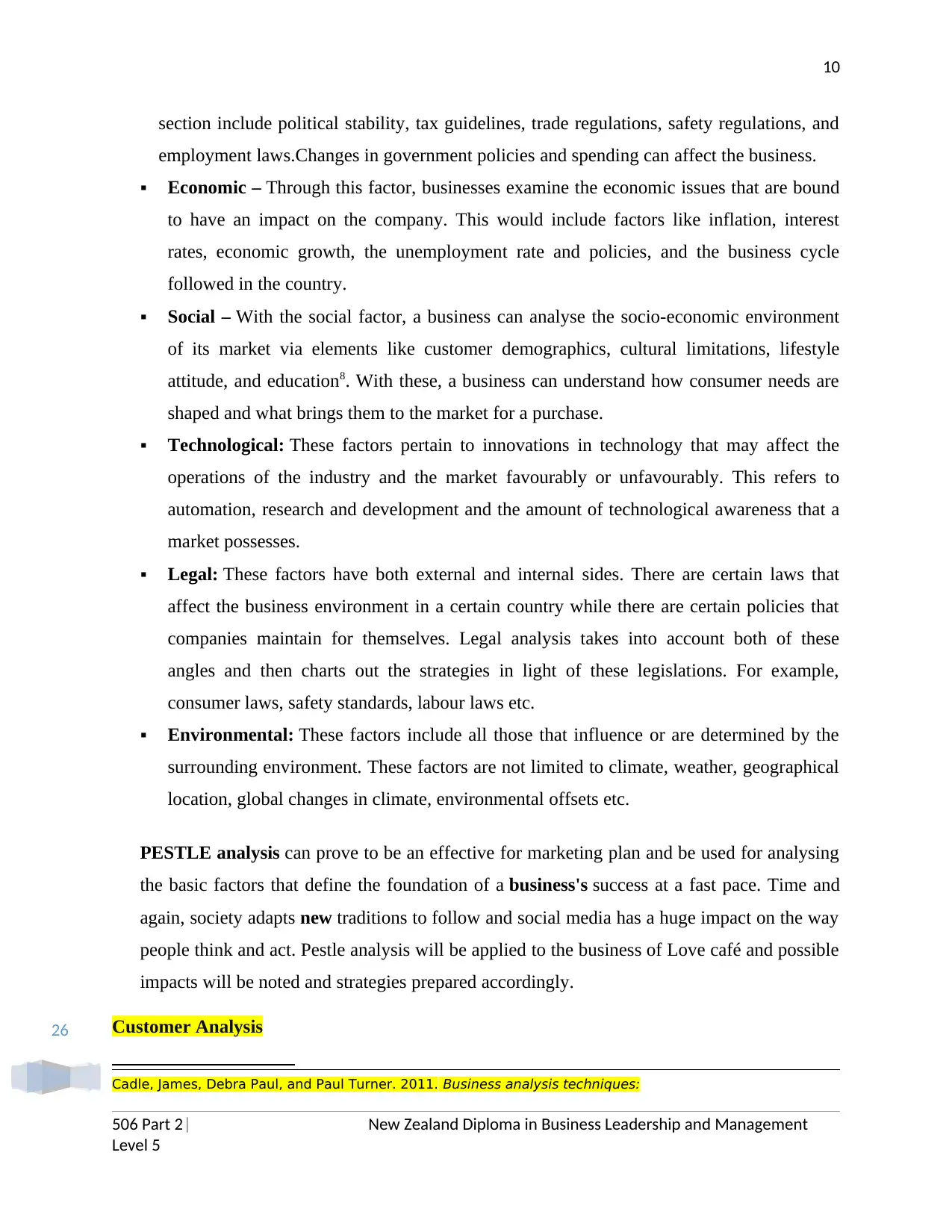
26
10
section include political stability, tax guidelines, trade regulations, safety regulations, and
employment laws.Changes in government policies and spending can affect the business.
Economic – Through this factor, businesses examine the economic issues that are bound
to have an impact on the company. This would include factors like inflation, interest
rates, economic growth, the unemployment rate and policies, and the business cycle
followed in the country.
Social – With the social factor, a business can analyse the socio-economic environment
of its market via elements like customer demographics, cultural limitations, lifestyle
attitude, and education8. With these, a business can understand how consumer needs are
shaped and what brings them to the market for a purchase.
Technological: These factors pertain to innovations in technology that may affect the
operations of the industry and the market favourably or unfavourably. This refers to
automation, research and development and the amount of technological awareness that a
market possesses.
Legal: These factors have both external and internal sides. There are certain laws that
affect the business environment in a certain country while there are certain policies that
companies maintain for themselves. Legal analysis takes into account both of these
angles and then charts out the strategies in light of these legislations. For example,
consumer laws, safety standards, labour laws etc.
Environmental: These factors include all those that influence or are determined by the
surrounding environment. These factors are not limited to climate, weather, geographical
location, global changes in climate, environmental offsets etc.
PESTLE analysis can prove to be an effective for marketing plan and be used for analysing
the basic factors that define the foundation of a business's success at a fast pace. Time and
again, society adapts new traditions to follow and social media has a huge impact on the way
people think and act. Pestle analysis will be applied to the business of Love café and possible
impacts will be noted and strategies prepared accordingly.
Customer Analysis
Cadle, James, Debra Paul, and Paul Turner. 2011. Business analysis techniques:
506 Part 2| New Zealand Diploma in Business Leadership and Management
Level 5
10
section include political stability, tax guidelines, trade regulations, safety regulations, and
employment laws.Changes in government policies and spending can affect the business.
Economic – Through this factor, businesses examine the economic issues that are bound
to have an impact on the company. This would include factors like inflation, interest
rates, economic growth, the unemployment rate and policies, and the business cycle
followed in the country.
Social – With the social factor, a business can analyse the socio-economic environment
of its market via elements like customer demographics, cultural limitations, lifestyle
attitude, and education8. With these, a business can understand how consumer needs are
shaped and what brings them to the market for a purchase.
Technological: These factors pertain to innovations in technology that may affect the
operations of the industry and the market favourably or unfavourably. This refers to
automation, research and development and the amount of technological awareness that a
market possesses.
Legal: These factors have both external and internal sides. There are certain laws that
affect the business environment in a certain country while there are certain policies that
companies maintain for themselves. Legal analysis takes into account both of these
angles and then charts out the strategies in light of these legislations. For example,
consumer laws, safety standards, labour laws etc.
Environmental: These factors include all those that influence or are determined by the
surrounding environment. These factors are not limited to climate, weather, geographical
location, global changes in climate, environmental offsets etc.
PESTLE analysis can prove to be an effective for marketing plan and be used for analysing
the basic factors that define the foundation of a business's success at a fast pace. Time and
again, society adapts new traditions to follow and social media has a huge impact on the way
people think and act. Pestle analysis will be applied to the business of Love café and possible
impacts will be noted and strategies prepared accordingly.
Customer Analysis
Cadle, James, Debra Paul, and Paul Turner. 2011. Business analysis techniques:
506 Part 2| New Zealand Diploma in Business Leadership and Management
Level 5
Paraphrase This Document
Need a fresh take? Get an instant paraphrase of this document with our AI Paraphraser
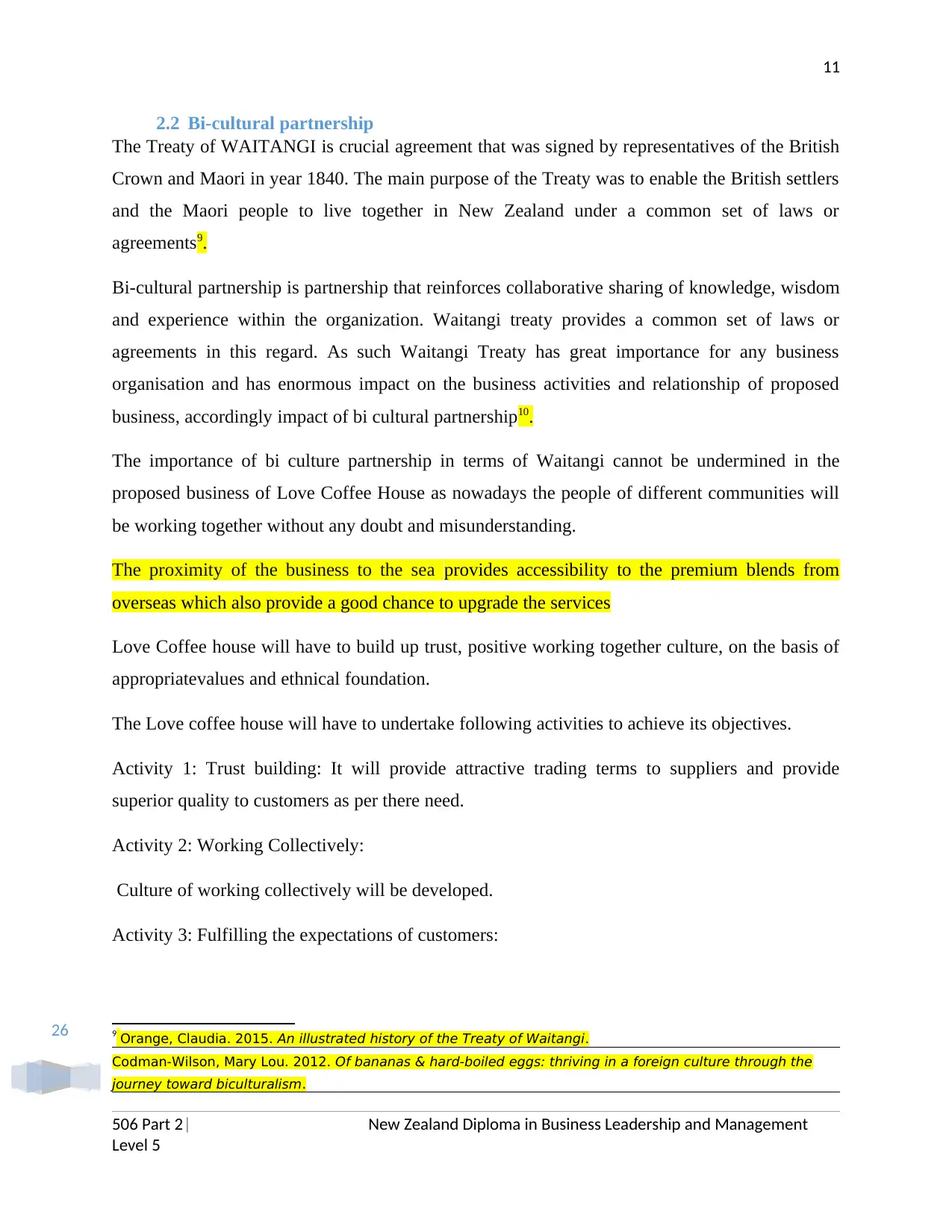
26
11
2.2 Bi-cultural partnership
The Treaty of WAITANGI is crucial agreement that was signed by representatives of the British
Crown and Maori in year 1840. The main purpose of the Treaty was to enable the British settlers
and the Maori people to live together in New Zealand under a common set of laws or
agreements9.
Bi-cultural partnership is partnership that reinforces collaborative sharing of knowledge, wisdom
and experience within the organization. Waitangi treaty provides a common set of laws or
agreements in this regard. As such Waitangi Treaty has great importance for any business
organisation and has enormous impact on the business activities and relationship of proposed
business, accordingly impact of bi cultural partnership10.
The importance of bi culture partnership in terms of Waitangi cannot be undermined in the
proposed business of Love Coffee House as nowadays the people of different communities will
be working together without any doubt and misunderstanding.
The proximity of the business to the sea provides accessibility to the premium blends from
overseas which also provide a good chance to upgrade the services
Love Coffee house will have to build up trust, positive working together culture, on the basis of
appropriatevalues and ethnical foundation.
The Love coffee house will have to undertake following activities to achieve its objectives.
Activity 1: Trust building: It will provide attractive trading terms to suppliers and provide
superior quality to customers as per there need.
Activity 2: Working Collectively:
Culture of working collectively will be developed.
Activity 3: Fulfilling the expectations of customers:
9 Orange, Claudia. 2015. An illustrated history of the Treaty of Waitangi.
Codman-Wilson, Mary Lou. 2012. Of bananas & hard-boiled eggs: thriving in a foreign culture through the
journey toward biculturalism.
506 Part 2| New Zealand Diploma in Business Leadership and Management
Level 5
11
2.2 Bi-cultural partnership
The Treaty of WAITANGI is crucial agreement that was signed by representatives of the British
Crown and Maori in year 1840. The main purpose of the Treaty was to enable the British settlers
and the Maori people to live together in New Zealand under a common set of laws or
agreements9.
Bi-cultural partnership is partnership that reinforces collaborative sharing of knowledge, wisdom
and experience within the organization. Waitangi treaty provides a common set of laws or
agreements in this regard. As such Waitangi Treaty has great importance for any business
organisation and has enormous impact on the business activities and relationship of proposed
business, accordingly impact of bi cultural partnership10.
The importance of bi culture partnership in terms of Waitangi cannot be undermined in the
proposed business of Love Coffee House as nowadays the people of different communities will
be working together without any doubt and misunderstanding.
The proximity of the business to the sea provides accessibility to the premium blends from
overseas which also provide a good chance to upgrade the services
Love Coffee house will have to build up trust, positive working together culture, on the basis of
appropriatevalues and ethnical foundation.
The Love coffee house will have to undertake following activities to achieve its objectives.
Activity 1: Trust building: It will provide attractive trading terms to suppliers and provide
superior quality to customers as per there need.
Activity 2: Working Collectively:
Culture of working collectively will be developed.
Activity 3: Fulfilling the expectations of customers:
9 Orange, Claudia. 2015. An illustrated history of the Treaty of Waitangi.
Codman-Wilson, Mary Lou. 2012. Of bananas & hard-boiled eggs: thriving in a foreign culture through the
journey toward biculturalism.
506 Part 2| New Zealand Diploma in Business Leadership and Management
Level 5
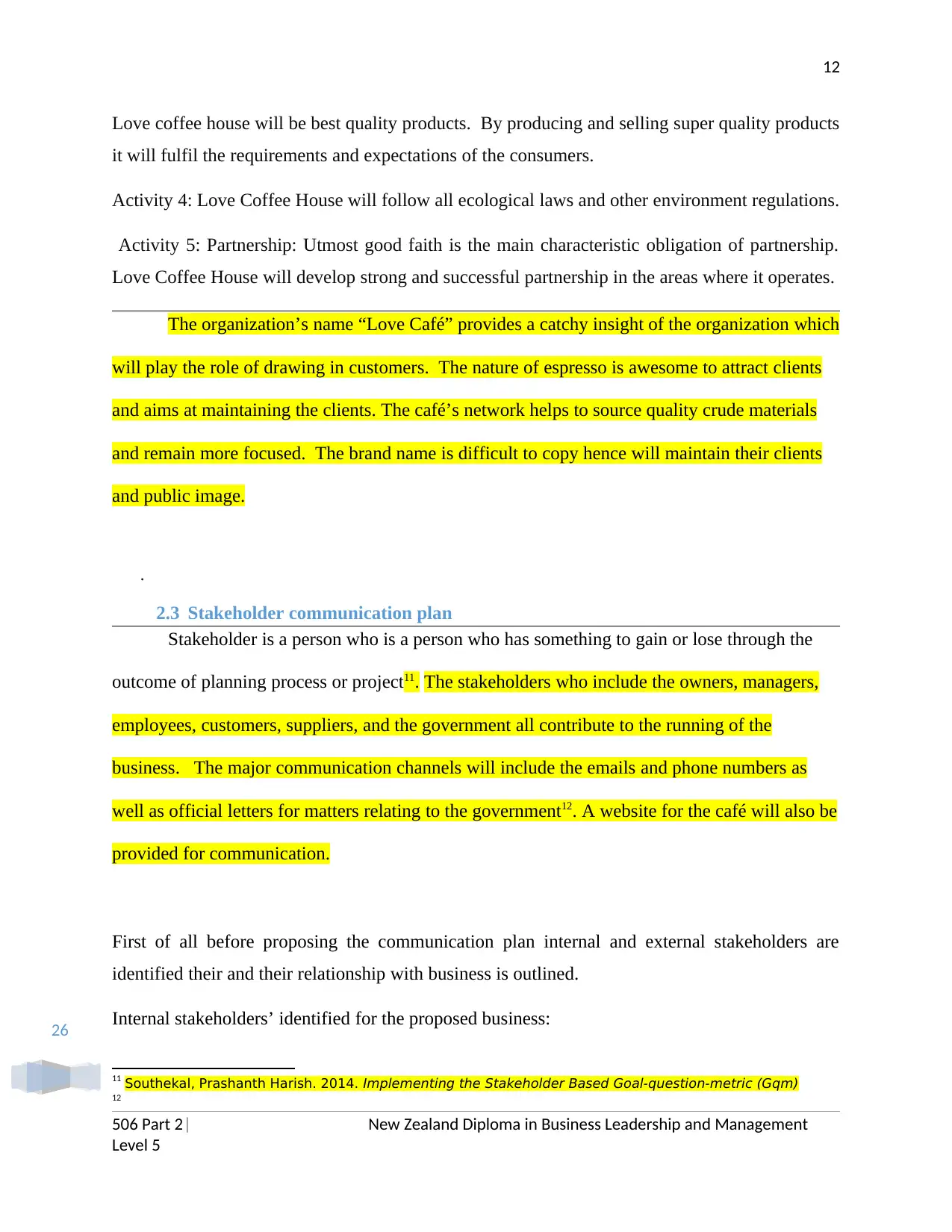
26
12
Love coffee house will be best quality products. By producing and selling super quality products
it will fulfil the requirements and expectations of the consumers.
Activity 4: Love Coffee House will follow all ecological laws and other environment regulations.
Activity 5: Partnership: Utmost good faith is the main characteristic obligation of partnership.
Love Coffee House will develop strong and successful partnership in the areas where it operates.
The organization’s name “Love Café” provides a catchy insight of the organization which
will play the role of drawing in customers. The nature of espresso is awesome to attract clients
and aims at maintaining the clients. The café’s network helps to source quality crude materials
and remain more focused. The brand name is difficult to copy hence will maintain their clients
and public image.
.
2.3 Stakeholder communication plan
Stakeholder is a person who is a person who has something to gain or lose through the
outcome of planning process or project11. The stakeholders who include the owners, managers,
employees, customers, suppliers, and the government all contribute to the running of the
business. The major communication channels will include the emails and phone numbers as
well as official letters for matters relating to the government12. A website for the café will also be
provided for communication.
First of all before proposing the communication plan internal and external stakeholders are
identified their and their relationship with business is outlined.
Internal stakeholders’ identified for the proposed business:
11 Southekal, Prashanth Harish. 2014. Implementing the Stakeholder Based Goal-question-metric (Gqm)
12
506 Part 2| New Zealand Diploma in Business Leadership and Management
Level 5
12
Love coffee house will be best quality products. By producing and selling super quality products
it will fulfil the requirements and expectations of the consumers.
Activity 4: Love Coffee House will follow all ecological laws and other environment regulations.
Activity 5: Partnership: Utmost good faith is the main characteristic obligation of partnership.
Love Coffee House will develop strong and successful partnership in the areas where it operates.
The organization’s name “Love Café” provides a catchy insight of the organization which
will play the role of drawing in customers. The nature of espresso is awesome to attract clients
and aims at maintaining the clients. The café’s network helps to source quality crude materials
and remain more focused. The brand name is difficult to copy hence will maintain their clients
and public image.
.
2.3 Stakeholder communication plan
Stakeholder is a person who is a person who has something to gain or lose through the
outcome of planning process or project11. The stakeholders who include the owners, managers,
employees, customers, suppliers, and the government all contribute to the running of the
business. The major communication channels will include the emails and phone numbers as
well as official letters for matters relating to the government12. A website for the café will also be
provided for communication.
First of all before proposing the communication plan internal and external stakeholders are
identified their and their relationship with business is outlined.
Internal stakeholders’ identified for the proposed business:
11 Southekal, Prashanth Harish. 2014. Implementing the Stakeholder Based Goal-question-metric (Gqm)
12
506 Part 2| New Zealand Diploma in Business Leadership and Management
Level 5
⊘ This is a preview!⊘
Do you want full access?
Subscribe today to unlock all pages.

Trusted by 1+ million students worldwide
1 out of 33
Related Documents
Your All-in-One AI-Powered Toolkit for Academic Success.
+13062052269
info@desklib.com
Available 24*7 on WhatsApp / Email
![[object Object]](/_next/static/media/star-bottom.7253800d.svg)
Unlock your academic potential
Copyright © 2020–2025 A2Z Services. All Rights Reserved. Developed and managed by ZUCOL.





